| In the United States,
significant precipitation over the past several months alleviated
drought conditions along the Pacific Northwest coast, although
severe to extreme drought classification continued through June
throughout the Intermountain West, the Northern Rockies, and
southward into Arizona. Exceptional drought classification was
noted through parts of Montana and Idaho. Moderate drought
conditions developed in parts of the Southeast by the end of April
and continued into June, although rainfall alleviated dryness in
this region by month's end. |

larger
image
|
For comprehensive drought analysis, please see the U.S. drought report
for June.
| Long term drought
continued across areas of Africa, including the Greater Horn and
parts of southern Africa (WFP). Seasonal rains brought relief to
some areas during late April and into May. |
 larger
image
larger
image
|
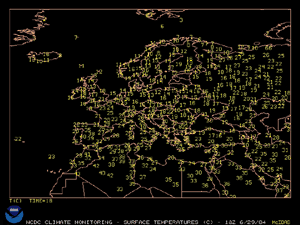 larger
image
larger
image
|
Maximum temperatures
across much of Spain reached or exceeded 40°C (104°F)
during the closing days of June, prompting electricity consumption
to soar to record levels (38,800 megawatts). On the 29th, Madrid
reached a 73-year high temperature of 39.3°C (104°F), while
Cordoba climbed to 42.3°C (108°F) (AFP/Spain National
Institute of Meteorology). |

 larger
image
larger
image
|
In the former Yugoslav
Republic of Macedonia, heavy rains during June 4-7 produced
flooding along the Pena, Vardar, Anska Reka, Trkajna and Turija
Rivers. Flooding affected up to 100,000 people and significantly
impacted agricultural interests. Up to 50 percent of the
agricultural land in the country was affected by the flooding
(OCHA). |
Thunderstorms produced flooding in northern Romania during the
12th-13th, claiming the life of a child in the town of Doljesti
(AFP).
Flooding resulting from heavy thunderstorm rains affected Lagos,
Nigeria late on the 16th and early on the 17th. Thousands of
commuters were stranded at bus stops as public transportation was
halted. Hundreds of buildings and properties were also submerged
(AFP).
In Nicaragua, heavy rainfall during June 20-30 produced flooding
and mudslides that killed 21 people (OCHA/Associated Press).
Heavy rainfall in the Sichuan province of southwestern China
produced flooding and landslides that caused 15 deaths (Associated
Press).
| In India, flooding
submerged at least 50 villages in the eastern state of Bihar by
mid-month. Heavy rainfall in neighboring Nepal was blamed as the
culprit for the flooding which caused three rivers that flow into
the state of Bihar to rise above the flood stage. Flooding across
the eastern states of India, including Tripura and Assam, was
blamed for 35 deaths by month's end (AFP). |
 larger
image
larger
image
|
For an archive of flood events worldwide, see the
Dartmouth Flood Observatory.

Strong thunderstorms downed trees and power lines in parts of
Wisconsin late on the 23rd. One fatality was reported in Green Lake
County (Associated Press).
In the Philippines, a rare tornado ripped through Leyte and
Samar islands on the 9th which destroyed 900 houses and killed at
least two people. The tornado was apparently spawned from Tropical
Storm Chanthu which was tracking through the region (Reuters).
Strong thunderstorms in the Bay of Bengal were responsible for
the sinking of 20 fishing vessels off the coast of Bangladesh on
the 13th. At least 10 deaths were blamed on the storms
(Reuters).
In northeastern China's Hubei province, severe thunderstorms
produced egg-sized hail in the city of Handan, injuring 32 people
and causing serious damage to houses, farmland and trees. The
thunderstorm knocked out electricity to the town and caused an
estimated $12.7 million (USD) in damage (AFP).
| In Turkey, a severe
thunderstorm on the 19th produced a rare tornado 30 km (20 miles)
north of Ankara. The tornado was responsible for 3 deaths and 21
injuries, while damaging 45 buildings (AFP). |
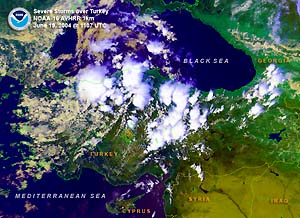 larger
image
larger
image
|

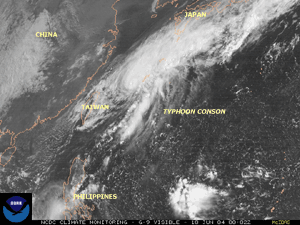 larger
image
larger
image
|
Typhoon Conson developed in
the South China Sea on the 4th as a depression, reaching typhoon
status by the 7th. Conson tracked between Taiwan and the
Philippines, attaining maximum sustained wind speeds of 175 km/hr
(95 knots or 110 mph) and disrupting air traffic to Taiwan.
Conson's weakened remnants passed over Japan on the 11th. |
| Typhoon Chanthu developed
on the 9th over the central Philippines. The storm brought heavy
rains and localized severe weather to the Philippines, before
tracking westward into the South China Sea on the 10th. Chanthu
reached typhoon strength by the 12th, tracking into central Vietnam
on the 13th with maximum sustained winds near 140 km/hr (75 knots
or 85 mph). The typhoon killed at least 12 people in Vietnam,
injured 5 and destroyed more than 180 houses (AFP/Associated
Press). |
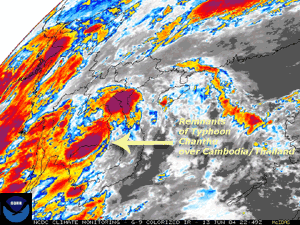 larger
image
larger
image
|
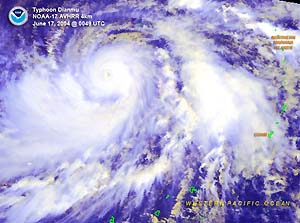 larger
image
larger
image
|
Typhoon Dianmu developed in
the western Pacific Ocean on the 13th and reached typhoon strength
by the 14th. Dianmu came ashore at Cape Muroto on Shikoku Island,
or about 500 km (310 miles) west of Tokyo, on the 21st. Wind gusts
on Shikoku Island were reported as high as 180 km/hr (112 mph) from
the Japanese Meteorological Agency. Dianmu weakened as it moved
northeastward across western Japan. The typhoon was blamed for five
deaths in Japan and adjacent South Korea (Reuters). |
| Typhoon Mindulle
developed in the western Pacific Ocean on the 23rd and battered the
northern Philippines during June 29-30. The typhoon passed north of
the main island of Luzon on the 30th with maximum sustained winds
near 165 km/hr (90 knots or 105 mph). Heavy rains produced flooding
that claimed 12 lives in the Philippines, while nearly 180,000
people were displaced from their homes. Strong winds toppled trees
and cut power to areas of northern Luzon island (AFP). |
 Satellite Animation (AVI format/1MB)
Satellite Animation (AVI format/1MB)
|
 larger
image
larger
image
|
Typhoon Tingting formed
in the western Pacific Ocean on the 25th, passing north of the
Northern Mariana Islands on the 28th with maximum sustained winds
near 140 km/hr (75 knots or 85 mph). The typhoon passed north of
Guam, but brought heavy rainfall (406 mm or 16 inches) and flooding
to the island. Rainfall in Guam for June was boosted to 966 mm
(38.03 inches) which was the wettest June on record. |
A table containing the
Accumulated Cyclone Energy (ACE) index for global tropical
cyclones occurring during the month of June 2004 is available.
| A strong storm system
affected much of Europe during June 22-23, bringing heavy
precipitation to parts of the region. A strong cold front ignited
severe thunderstorms which affected parts of Germany on the 23rd.
Two people were killed and several injured as wind gusts up to 115
km/hr (65 mph) produced widespread wind damage. A tornado struck
the village of Micheln injuring at least 6 people and tearing roofs
from homes (AFP). |
 Satellite Animation (5MB)
Satellite Animation (5MB)
|

No reports of severe winter weather were received during June
2004
References:
Basist, A., N.C. Grody, T.C. Peterson and C.N. Williams, 1998:
Using the Special Sensor Microwave/Imager to Monitor Land Surface
Temperatures, Wetness, and Snow Cover. Journal of Applied
Meteorology, 37, 888-911.
Peterson, Thomas C. and Russell S. Vose, 1997: An overview of
the Global Historical Climatology Network temperature data base.
Bulletin of the American Meteorological Society,
78, 2837-2849.
|


 NOAA's National Centers for Environmental Information
NOAA's National Centers for Environmental Information NOAA's National Centers for Environmental Information
NOAA's National Centers for Environmental Information
